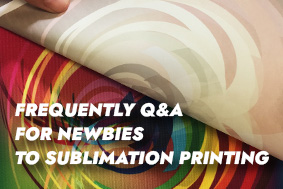Sublimation ink is a special digital printing ink designed for the sublimation printing process. Sublimation printing is widely used in apparel, home textiles, advertising, crafts and many other industries. High-quality sublimation ink has very good results in terms of color saturation, pattern fineness, dye transfer rate, and reduction of printhead loss and printer maintenance. However, sublimation ink in the production of finished products will be affected by the process leading to ink fastness and color migration degree is subject to different degrees of constraints, the specific impact of the following factors:
01 Some sublimation inks are low temperature dyes.
Applied to polyester fabrics, plus the heat transfer process dispersed dyes will become gas, and part of the dyes from the fiber to the fiber surface migration, will be stained to the surface of the fabric fabric to form a floating color, the deeper the amount of ink floating color the heavier, more than the fabric carrying capacity, washing or friction is easy to fall.
02 Transfer the temperature, time, and pressure of the press machine
Transfer requires temperature control in the range of 180℃-230℃, time of about 10-30s, pressure 0.3mpa-0.4mpa, according to the application of the actual situation to choose the right transfer parameters is important.
03 Quality of transfer paper
Choosing a better-coated sublimation paper can help to improve the transfer rate and reduce ink residue.
04 Fabric suitability
Certain fabrics need to achieve a good handfeel for specific effects and add additives such as surfactants and softeners, resulting in a reaction with the dye.
05 Transfer environment temperature and storage temperature control
In the transfer and storage process, especially with the high temperature in summer, migration occurs, for example, facecloth is not good for heat dissipation, especially red compared to the other three colors are easy to sublimation, resulting in such color change, staining when ironing, friction resistance, washing resistance, light fastness decreased.
For these factors, we can take the following measures:
01 Choose high-temperature dyes, which have a long color development time and also are more expensive.
02 Different transfer paper in the same color-emitting conditions, the OD value, and residual rate are significantly different, and the color printing effect there is a significant difference. Do thermal transfer printing sampling need to be done for fastness and migration test, the big goods on the color of the sample to do the relevant requirements of the test.
03 The difference in ink volume will lead to the same fabric in the finished output of different degrees of color loss problems. Adjustable color to reduce the proportion of ink, curve to reduce the amount of single-channel ink, color depth has been reduced, try to increase the temperature of the transfer machine color completely, while reducing the floating color.
04 In the selection of fabrics to be tested, as little as possible with additives.
05 According to different fabrics and materials reasonable control of the heat press machine temperature, time, and pressure. The roller transfer machine also needs to adjust the speed according to the characteristics of the fabric, and the back row of cooling heat when the roll is closed.
06 Lining a layer of paper between the fabric and the fabric, so that the color migration does not migrate to the finished fabric.
07 Restore cleaning after transferring to remove floating color.
In short, in the use of sublimation ink as a raw material for production, we need to strictly control the production process of various environmental factors, as far as possible, so that the occurrence of heat migration phenomenon is controlled within the minimum range, thereby reducing the impact on the finished fabric and reducing losses.
 Easy-to-Design Mother's Day Gift Ideas
Easy-to-Design Mother's Day Gift Ideas
 Frequently Q&A for Newbies to Sublimation Printing
Frequently Q&A for Newbies to Sublimation Printing
 Choose sublimation paper? Focus on quality over price
Choose sublimation paper? Focus on quality over price
 7 Factors To Consider Before Choosing A Digital Textile Printer
7 Factors To Consider Before Choosing A Digital Textile Printer